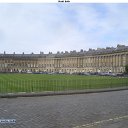UNESCO Welterbe Europa: Galerie & Aufnahmekriterien
Erfüllte Kriterien für die Aufnahme in die UNESCO-Welterbeliste:
(i) (ii) (iv)
Entscheidung: 11COM VII.A, Ref/ID 428 (11. Sitzung, Paris/Frankreich, 1987)
|
|
Kriterien für die Aufnahme:
Das Komitee betrachtet ein Gut als von außergewöhnlichem universellem Wert, wenn das Gut einem oder mehreren der folgenden Kriterien entspricht. Angemeldete Güter sollten daher
|
Begründung für die Aufnahme: |
(i) ein Meisterwerk der menschlichen Schöpferkraft darstellen
|
(i) Bath's grandiose Neo-classical Palladian crescents, terraces, and squares spread out over the surrounding hills and set in its green valley are a demonstration par excellence of the integration of architecture, urban design, and landscape setting, and the deliberate creation of a beautiful city. Not only are individual buildings such as the Assembly Rooms and Pump Room of great distinction, they are part of the larger overall city landscape that evolved over a century in a harmonious and logical way, drawing together public and private buildings and spaces in a way that reflects the precepts of Palladio tempered with picturesque aestheticism.
[Übersetzung in meinem kommenden Buch]
|
(ii) für einen Zeit- oder in einem Kulturgebiet der Erde einen bedeutenden Schnittpunkt menschlicher Werte in Bezug auf Entwicklung der Architektur oder Technik, der Großplastik, des Städtebaus oder der Landschaftsgestaltung aufzeigen
|
(ii) Bath exemplifies the 18th century move away from the inward-looking uniform street layouts of Renaissance cities that dominated through the 15th–17th centuries, towards the idea of planting buildings and cities in the landscape to achieve picturesque views and forms, which could be seen echoed around Europe, particularly in the 19th century. This unifying of nature and city, seen throughout Bath, is perhaps best demonstrated in the Royal Crescent (John Wood Younger) and Lansdown Crescent (John Palmer). Bath's urban and landscape spaces are created by the buildings that enclose them, providing a series of interlinked spaces that flow organically, and that visually (and at times physically) draw in the green surrounding countryside to create a distinctive garden city feel, looking forward to the principles of garden cities developed by the 19th century town planners.
[Übersetzung in meinem kommenden Buch]
|
(iii) ein einzigartiges oder zumindest außergewöhnliches Zeugnis von einer kulturellen Tradition oder einer bestehenden oder untergegangenen Kultur darstellen
|
|
(iv) ein hervorragendes Beispiel eines Typus von Gebäuden, architektonischen oder technologischen Ensembles oder Landschaften darstellen, die einen oder mehrere bedeutsame Abschnitte der Menschheits-Geschichte versinnbildlichen
|
(iv) Bath reflects two great eras in human history: Roman and Georgian. The Roman Baths and temple complex, together with the remains of the city of Aquae Sulis that grew up around them, make a significant contribution to the understanding and appreciation of Roman social and religious society. The 18th century redevelopment is a unique combination of outstanding urban architecture, spatial arrangement, and social history. Bath exemplifies the main themes of the 18th century neoclassical city; the monumentalisation of ordinary houses, the integration of landscape and town, and the creation and interlinking of urban spaces, designed and developed as a response to the growing popularity of Bath as a society and spa destination and to provide an appropriate picturesque setting and facilities for the cure takers and social visitors. Although Bath gained greatest importance in Roman and Georgian times, the city nevertheless reflects continuous development over two millennia with the spectacular medieval Abbey Church sat beside the Roman temple and baths, in the heart of the 18th century and modern city.
[Übersetzung in meinem kommenden Buch]
|
(v) ein hervorragendes Beispiel einer überlieferten menschlichen Siedlungsform, Boden- oder Meeresnutzung darstellen,die für eine oder mehrere bestimmte Kulturen typisch ist, oder der Wechselwirkung zwischen Mensch und Umwelt, insbesondere, wenn diese unter dem Druck unaufhaltsamen Wandels vom Untergang bedroht wird
|
|
(vi) in unmittelbarer oder erkennbarer Weise mit Ereignissen oder überlieferten Lebensformen, mit Ideen oder Glaubensbekenntnissen oder mit künstlerischen oder literarischen Werken von außergewöhnlicher universeller Bedeutung verknüpft sein. (Das Komitee ist der Ansicht, dass dieses Kriterium in der Regel nur in Verbindung mit einem weiteren Kriterium angewandt werden sollte)
|
|
(vii) überragende Naturerscheinungen oder Gebiete von außergewöhnlicher Naturschönheit und ästhetischer Bedeutung aufweisen
|
|
(viii) außergewöhnliche Beispiele der Hauptstufen der Erdgeschichte darstellen, einschließlich der Entwicklung des Lebens, wesentlicher im Gang befindlicher geologischer Prozesse bei der Entwicklung von Landschaftsformen oder wesentlicher geomorphologischer oder physiographischer Merkmale
|
|
(ix) außergewöhnliche Beispiele bedeutender im Gang befindlicher ökologischer und biologischer Prozesse in der Evolution und Entwicklung von Land-, Süßwasser-, Küsten- und Meeres-Ökosystemen sowie Pflanzen- und Tiergemeinschaften darstellen
|
|
(x) die für die In-situ-Erhaltung der biologischen Vielfalt bedeutendsten und typischsten Lebensräume enthalten, einschließlich solcher, die bedrohte Arten enthalten, welche aus wissenschaftlichen Gründen oder ihrer Erhaltung wegen von außergewöhnlichem universellem Wert sind.
|
|
Quelle: Deutsche UNESCO-Kommission e.V. |
Quelle: UNESCO World Heritage Centre |



